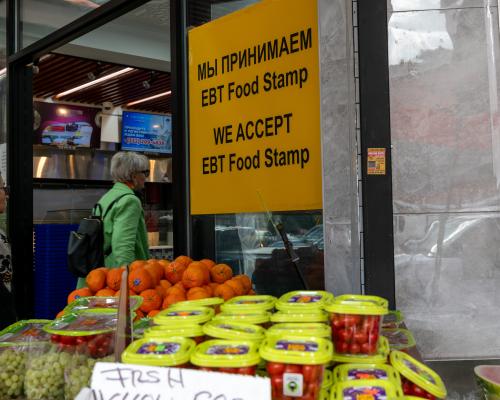
Republican-led cuts to public assistance programs – carried out at the behest of Donald Trump’s administration – will lead to 2.4 million fewer Americans receiving food stamps, among them families with children, the non-partisan congressional budget office (CBO) has found.
The estimate, published Monday, forecast that the number of people receiving food stamp benefits in an average month would drop after Republican lawmakers expanded work requirements to some parents, older enrollees and others.
The Supplemental Nutrition Assistance Program (Snap), formerly known as food stamps, in 2024 served an average of 41.7 million people monthly, or 12.3% of the US population. Federal spending on the program amounts to almost $100bn, and benefits average $187.20 a month.
But Trump’s congressional agenda bill, which the president signed into law in July, requires parents of dependent children to work for their food stamp benefits. The Snap program has long required certain able-bodied adults to work to receive benefits for longer than three months.
But the bill broadened the requirement to parents of dependent children – requiring that those with kids ages 14 and older work, volunteer or participate in job training at least 80 hours monthly.
The bill – which places more responsibility for food programs and other benefits onto states – requires that adults ages 55 to 64, veterans, people experiencing homelessness and former foster care youth meet the mandate, though it exempts Native Americans, according to CNN.
The CBO estimates that US households, on average, will see an increase in the resources available to them as a result of the bill – but “the changes in resources will not be evenly distributed among households”.
Those who may lose SNAP benefits include 300,000 adults who live with children ages 14 and older, the CBO estimates.
The agency said it “estimates that, in general, resources will decrease for households toward the bottom of the income distribution, whereas resources will increase for households in the middle and toward the top of the income distribution”.
But the highest earners, with incomes of nearly $700,000, on average, will see a $13,600 jump in their incomes, or about 2.7%.
Overall, middle-income Americans, who earn about $86,000 on average, will get an $800 increase in federal assistance overall while those who earn less than $24,000 will see their projected incomes drop by about $1,200 a year.
The estimates come as the federal government is shifting costs of benefit programs onto states.
“Hunger is a public health crisis, and Snap is one of the most effective tools we have to address it – reducing food insecurity, improving health outcomes, and lowering long-term health care costs,” the Food Research & Action Center said recently, after the federal Department of Health and Human Services (HHS) moved to restrict certain junk foods, including sodas and candy, from products that can be purchased with Snap benefits.
“For years, Snap has used taxpayer dollars to fund soda and candy – products that fuel America’s diabetes and chronic disease epidemics,” HHS Secretary Robert F Kennedy Jr said in a statement.
But the Food Research & Action Center said the Trump administration “needs to stop being the food police and start investing in real solutions”.
“That means increasing SNAP benefits, expanding access to affordable food, and scaling up evidence-based programs like fruit and vegetable incentives,” the group said.




